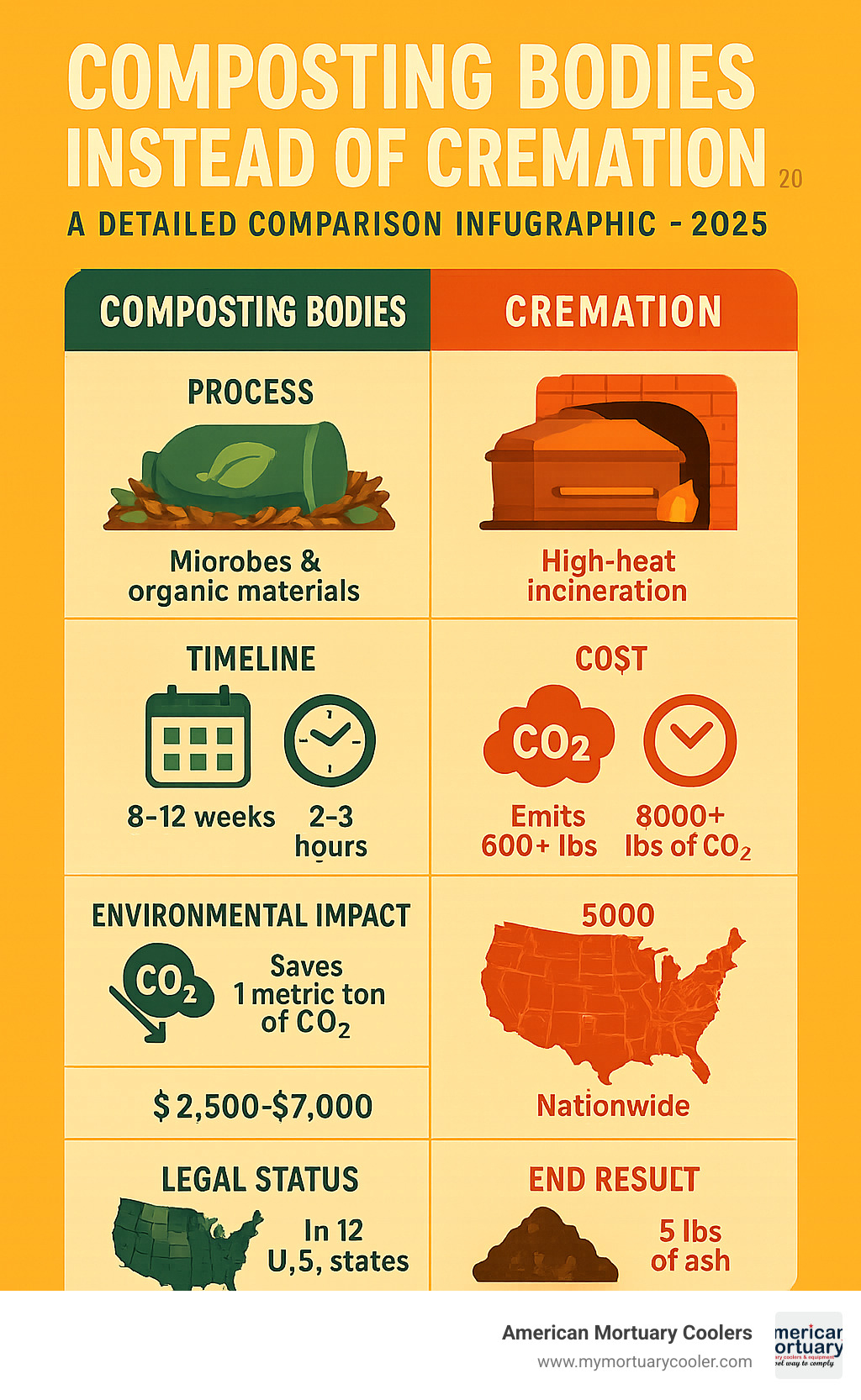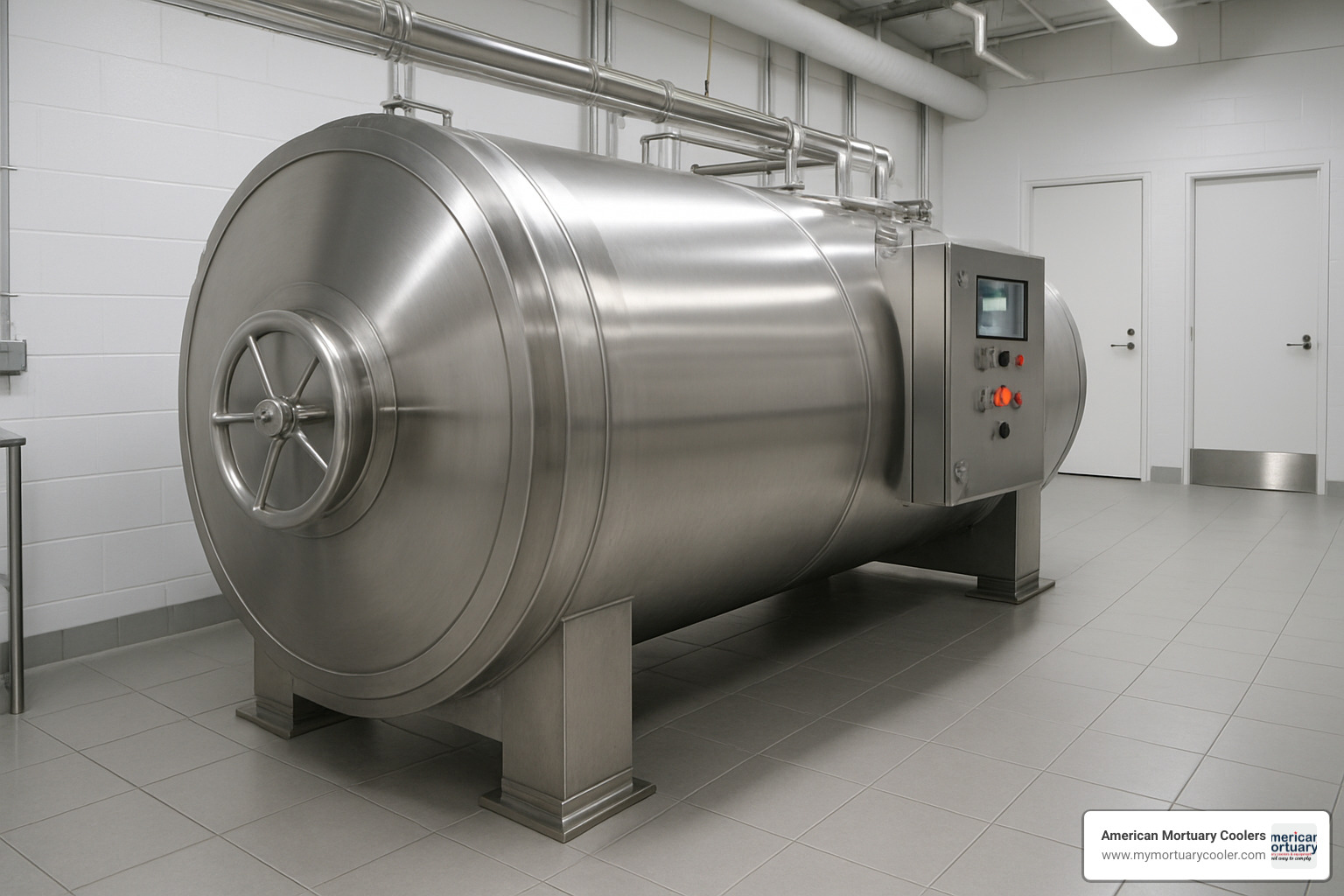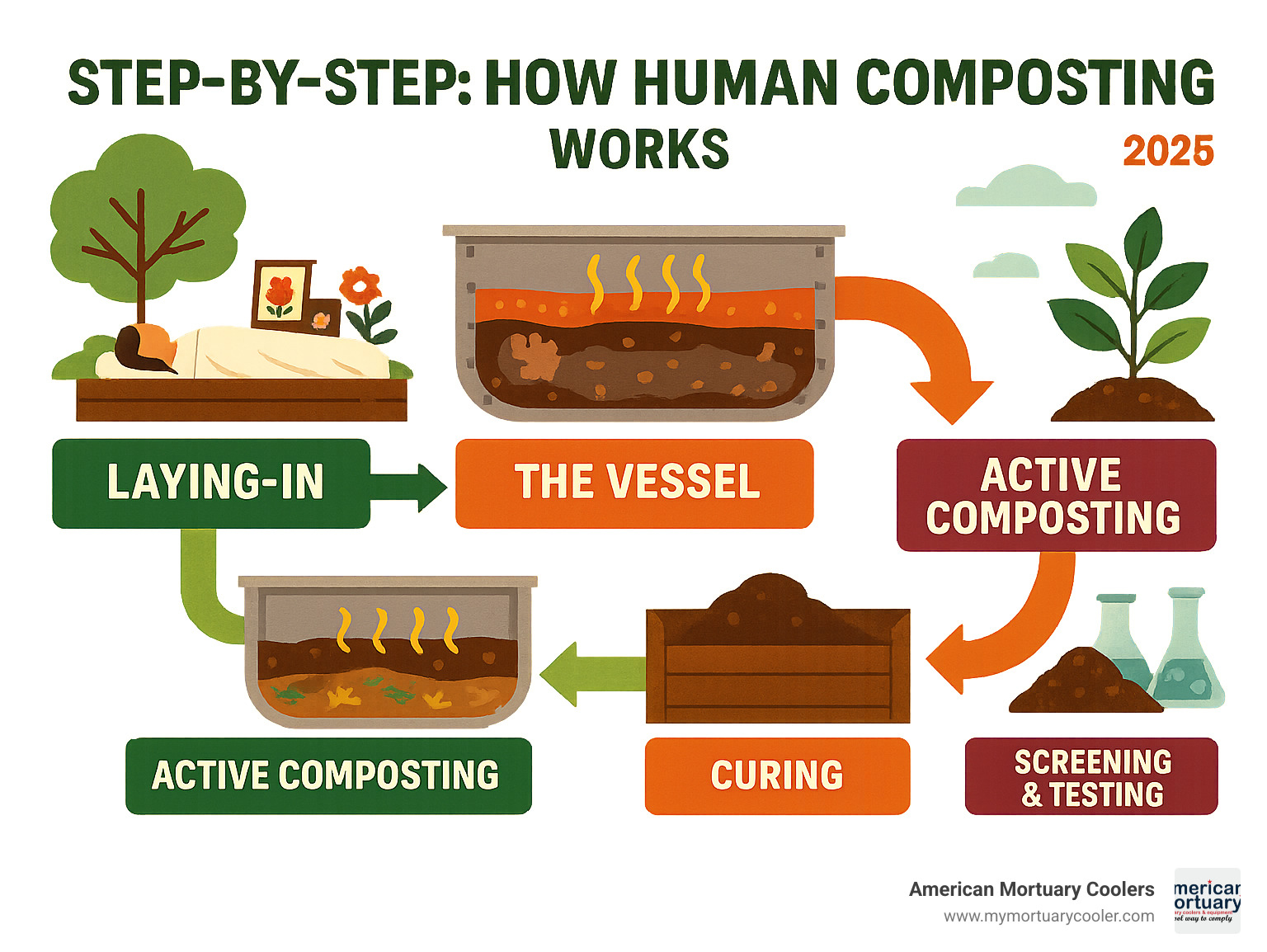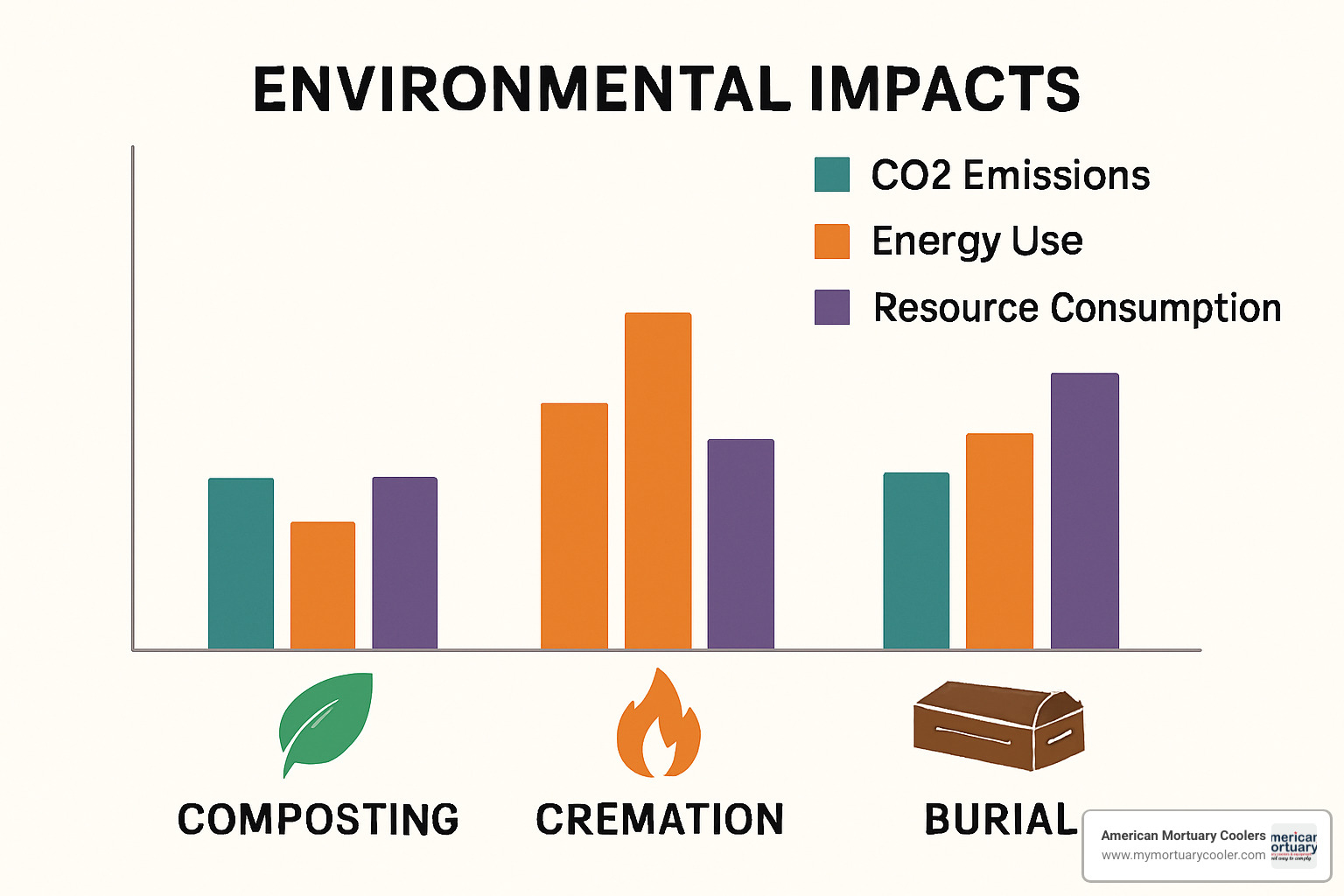
Composting Bodies vs Cremation: A Practical Guide to Your Options
Why Sustainable Death Care Is Changing America's Funeral Industry
Composting bodies instead of cremation is a legal, eco-friendly process that transforms human remains into nutrient-rich soil through natural organic reduction. Here's what you need to know:
Key Differences:
- Process: Composting uses microbes and organic materials; cremation uses high-heat incineration
- Timeline: Composting takes 8-12 weeks; cremation takes 2-3 hours
- Environmental Impact: Composting saves 1 metric ton of CO₂; cremation emits 600+ lbs of CO₂
- Cost: Composting ranges $2,500-$7,000; cremation averages $7,000
- End Result: Composting yields 1 cubic yard of soil; cremation produces 5 lbs of ash
- Legal Status: Available in 12 U.S. states; cremation available nationwide
When Sean Hanna's partner dreamed of "becoming mushrooms" after death, human composting made that vision possible. This emerging option addresses growing concerns about cremation's environmental impact while offering families a way to literally give back to the earth.
Traditional cremation emits over 600 pounds of CO₂ per body, while human composting actually sequesters carbon and uses 87% less energy. For funeral directors serving environmentally conscious families, understanding this alternative becomes increasingly important as demand grows.
As American Mortuary Coolers with years of experience in sustainable funeral equipment, I've witnessed the growing interest in composting bodies instead of cremation among forward-thinking funeral homes. This guide will help you understand both options so you can better serve families seeking environmentally responsible end-of-life choices.

Composting bodies instead of cremation terms explained:
What Is Human Composting (Natural Organic Reduction)?
Composting bodies instead of cremation works like nature's recycling system - the same process that transforms fallen leaves into rich forest soil, but in a carefully controlled environment.
Human composting, officially called Natural Organic Reduction (NOR), uses beneficial microbes that naturally exist in our bodies and environment. These microbes break down human remains and transform them into nutrient-rich soil that supports plant growth and ecosystem health.
Scientific research on composting process shows remarkable results. Each person becomes approximately one cubic yard of fertile soil, weighing between 500 and 1,000 pounds. The soil has a perfect pH balance of 6.5 to 7, ideal for supporting new plant life.

The process happens inside stainless steel vessels filled with organic materials like wood chips, alfalfa, and straw. These materials create perfect conditions for thermophilic microbes that thrive in heat and facilitate the change process.
History & Current Popularity
Washington State made history in May 2019 as the first place worldwide to legalize human composting. Colorado followed in 2021, then Oregon in 2022, creating momentum across the nation.
Today, 12 states have legalized human composting: Washington, Colorado, Oregon, Vermont, Nevada, California (starting in 2027), New York, Arizona, Maryland, Delaware, Minnesota, and Maine. Bills are pending in Texas, Indiana, and other states.
This growth reflects changing American attitudes toward death care. About 60% of people now choose cremation over traditional burial, and environmental concerns are pushing many toward even greener options. Return Home in Seattle serves families from all 49 other U.S. states and throughout Canada, showing the nationwide demand for this choice.
Canadian residents can access services through facilities like Return Home, which handles all international transportation and returns the resulting soil to families within 12 weeks.
Step-by-Step: How Human Composting Works
When families choose composting bodies instead of cremation, they begin a gentle, natural process that unfolds over several months. Unlike cremation's rushed timeline, human composting allows time for meaningful goodbyes and connection.
The journey begins with the laying-in ceremony. Your loved one is wrapped in a natural shroud and placed gently in the composting vessel. Many families bring flowers, photos, or mementos to create a peaceful, personalized space.
The vessel is a stainless steel container about 8 feet long and 4 feet tall that houses a carefully balanced ecosystem. Your loved one rests among wood chips for carbon, alfalfa for nitrogen, and straw for structure - a precise 3:1 carbon-to-nitrogen ratio that creates perfect conditions for beneficial microbes.

For 5-7 weeks, the vessel maintains temperatures between 131-160°F from natural microbial activity. This heat eliminates harmful pathogens while allowing beneficial microbes to transform everything into rich, fertile soil.
The curing phase follows for another 3-5 weeks in curing bins, where the compost stabilizes and completes its change. The final soil undergoes careful screening and laboratory testing to ensure safety standards are met.
What Happens to Bones, Teeth, and Implants?
Bones and teeth require additional processing after the vessel phase. Remaining bone fragments are mechanically reduced to fine powder using specialized equipment, then mixed back into the final soil, adding valuable minerals like calcium and phosphorus.
Medical implants are carefully removed and screened out. Pacemakers must be removed before processing for safety, while metal implants are often recycled, fitting the environmental spirit of human composting.
Safety standards ensure those high temperatures (131-160°F for at least three continuous days) eliminate all pathogens, meeting or exceeding state health department requirements.
Family Roles & Memorial Ceremonies
Composting bodies instead of cremation invites families to participate in the journey. Most facilities welcome family visits during business hours, allowing you to decorate vessels, leave photos, or sit quietly nearby.
Ceremonies can happen throughout the process - from laying-in ceremonies to memorial services at the facility. Some families hold seasonal ceremonies marking the beginning, middle, and completion of the process.
The soil return offers beautiful possibilities. You receive about one cubic yard of rich soil - enough for substantial memorial gardens or several trees. You can keep it all, use some for personal memorials, or donate excess to conservation projects.
More info about Human Composting Options provides details on personalizing this experience and making meaningful choices about soil use.
Composting Bodies vs Cremation: Environmental & Cost Comparison
When families ask about the environmental impact of composting bodies instead of cremation, the numbers often surprise them. While cremation has been seen as eco-friendly compared to traditional burial, human composting takes sustainability much further.
Cremation requires massive furnaces reaching 1,400-2,100°F for 2-3 hours, consuming enormous amounts of natural gas or propane. Each cremation releases over 600 pounds of CO₂, plus mercury vapor from dental fillings and other pollutants.
Human composting uses natural microbial activity that consumes 87% less energy than cremation. Instead of releasing carbon, each composted body sequesters approximately one metric ton of CO₂ - creating a carbon-negative process that fights climate change.
Scientific research on mercury pollution shows how dental fillings release toxic mercury vapor during cremation's high-heat process. Human composting eliminates this concern entirely.
| Factor | Human Composting | Cremation | Traditional Burial |
|---|---|---|---|
| CO₂ Emissions | Carbon negative (sequesters ~1 ton) | 600+ lbs CO₂ | Varies by casket/vault |
| Energy Use | 87% less than cremation | High (1,400-2,100°F for 3+ hours) | Moderate |
| Timeline | 8-12 weeks | 2-3 hours processing | 1-2 weeks preparation |
| Cost Range | $2,500-$7,000 | $1,000-$7,000+ | $7,000-$15,000+ |
| End Product | 1 cubic yard soil | 5 lbs ash | Preserved body |
| Pollution | None | Mercury, CO₂, particulates | Groundwater risk |

Environmental Impact Numbers
Cremation burns fossil fuels equivalent to a 500-mile car trip for every body processed. Multiply by roughly 1.5 million annual cremations, and the energy consumption becomes massive.
Traditional burial consumes 4 million acres of forest annually for caskets, while embalming uses over 800,000 gallons of toxic chemicals that leach into groundwater.
Human composting reverses this resource drain. Each composted body creates soil that continues benefiting the environment for decades - sequestering carbon, supporting plant growth, improving soil health, and helping restore damaged ecosystems.
Cost Comparison
While "direct cremation" advertises around $1,000, full cremation services typically run $6,000-$7,000 or more with facilities, staff, and basic memorialization.
Human composting ranges $2,500-$7,000, covering everything from preparation through soil return. No ongoing costs exist - unlike traditional burial with perpetual cemetery fees and maintenance expenses.
Many facilities offer pre-planning payment options and community assistance funds, making sustainable death care accessible regardless of budget.
Legal Status, Logistics & Future Outlook
The legal journey for composting bodies instead of cremation started with Washington State in 2019 and has grown into a nationwide movement.
12 states have legalized human composting: Washington, Colorado, Oregon, Vermont, Nevada, California (starting 2027), New York, Arizona, Maryland, Delaware, Minnesota, and Maine. Bills are pending in Texas, Indiana, and other states.
Unlike cremation's decades-long acceptance journey, human composting is moving through legislatures at record pace, with bipartisan support for environmental benefits and personal choice.

Geography doesn't limit choices. Companies like Return Home serve families from all 49 other states and throughout Canada, handling transport logistics and returning finished soil within 12 weeks.
More info about where body composting is legal provides current state regulations and access options.
How to Arrange Composting Bodies Instead of Cremation Today
Pre-planning starts with research. Check your state's legal status, then explore nearby states if needed. Most facilities offer virtual consultations and transparent pricing with payment plans.
Transportation logistics are handled by experienced facilities for out-of-state families, coordinating with local funeral homes for permits and dignified care throughout the journey.
Family involvement opportunities vary by facility - from laying-in ceremonies to regular updates during the 8-12 week process. Soil decisions require planning whether to keep for memorial gardens or donate to conservation projects.
The Future of Body Composting
Market growth accelerates as environmentally conscious baby boomers plan their final acts of earth stewardship. Policy momentum continues with bipartisan legislative support across states.
Technology improvements make the process more efficient while cultural acceptance grows through word-of-mouth from satisfied families. Traditional funeral homes are partnering with composting facilities or adding services to meet shifting consumer preferences.
The next decade will likely see human composting become as common as cremation, with social media and environmental awareness accelerating adoption timelines dramatically.
Benefits, Criticisms & Safety Considerations
When families consider composting bodies instead of cremation, they weigh environmental values, spiritual beliefs, and practical concerns. Human composting offers compelling advantages alongside legitimate concerns deserving honest discussion.
Environmental benefits are striking. While cremation emits 600+ pounds of CO₂, human composting removes carbon from air and locks it in soil. Each composted body creates fertile earth nourishing plants for decades.
Cost effectiveness often surprises families. Without ongoing cemetery fees or expensive caskets, human composting frequently costs less than traditional burial while providing tangible soil for memorial trees or landscape restoration.
Personal involvement appeals to many families. Unlike cremation's quick industrial process, composting allows visits during the 8-12 week timeline, with families decorating vessels and feeling connected to their loved one's change.
Challenges include religious objections from some faith communities and unfamiliarity making people uncomfortable with non-traditional practices. Limited availability frustrates families in non-legal states, while extended timelines challenge those expecting immediate closure.
Addressing Ethical & Religious Concerns
Religious perspectives reflect faith communities wrestling with how ancient wisdom applies to modern innovation.
Catholic positions remain evolving, with some bishops expressing concerns while others find meaning in the practice. One priest noted "only human composting fulfills the Catholic prayer of Committal" - returning dust to dust.
Jewish communities show thoughtful consideration, as traditional law emphasizes returning bodies to earth quickly and naturally - principles aligning with human composting. Reform and Conservative congregations often accept environmental stewardship aspects.
Protestant traditions generally focus on spirit destination over body disposition, creating openness among many believers. Individual congregations decide based on personal conviction and pastoral guidance.
Many facilities work with chaplains and religious leaders to develop ceremonies honoring various faith traditions while accommodating the composting process.
Safety & Scientific Validation
Pathogen elimination occurs through sustained temperatures of 131-160°F for at least three continuous days, destroying all known pathogens including prions, viruses, bacteria, and parasites.
Laboratory testing of finished soil checks heavy metals, pH balance, nutrients, and contaminants. Only soil meeting strict agricultural standards gets released to families.
State licensing requirements ensure facilities maintain professional standards with proper equipment, qualified staff, regular inspections, and compliance monitoring protecting workers and public.
Frequently Asked Questions about composting bodies instead of cremation
How long does the process take and what do I receive?
The complete human composting process takes 8-12 weeks from start to finish - quite different from cremation's 2-3 hour timeline.
Your loved one spends 5-7 weeks in the composting vessel at temperatures between 131-160°F, followed by 3-5 weeks of curing and testing to ensure safety standards.
Many families find comfort in this gradual timeline, describing it as giving their loved one time to "become part of the earth slowly and peacefully."
You receive approximately one cubic yard of nutrient-rich soil - between 500-1,000 pounds of dark, fertile earth with balanced pH of 6.5-7, perfect for supporting plant growth.
Is the resulting soil safe and how can it be used?
The soil is extensively tested and certified safe. State regulations require laboratory analysis for pathogens, heavy metals, pH levels, and nutrients before release to families.
Sustained high temperatures eliminate all harmful microorganisms, exceeding safety standards for conventional composting operations.
Families use soil for memorial plantings like trees or gardens, home gardening projects, or conservation donation to ecosystem restoration projects. Scattering remains an option with landowner permission.
Most families keep portions for personal memorials while donating the majority to conservation efforts.
What does it cost compared to cremation or burial?
Human composting typically costs $2,500-$7,000, competitive with other options.
Direct cremation seems affordable at $1,000-$3,000, but full cremation services typically run $6,000-$7,000 or more with facilities and proper memorialization.
Traditional burial ranges $7,000-$15,000+ before cemetery plots, headstones, and ongoing maintenance fees.
Composting prices include everything: preparation, complete change, ceremonies, soil testing, and return coordination. No hidden fees or ongoing costs - just comprehensive service covering the entire journey.
Conclusion
Composting bodies instead of cremation represents a regenerative choice changing death into new life. As environmental consciousness grows and traditional death care costs rise, human composting offers families a way to align their final act with their values.
The benefits are clear: saving over one metric ton of CO₂ per body, using 87% less energy than cremation, and creating nutrient-rich soil restoring ecosystems for decades. For the 60% of Americans choosing cremation, human composting provides an even greener alternative that actively benefits the environment.
At American Mortuary Coolers, we've witnessed the funeral industry's evolution toward sustainable practices. From our Tennessee headquarters, we craft custom mortuary equipment and deliver directly to funeral homes across the contiguous 48 states - from regional hubs in Atlanta and Chicago to Columbia, Dallas, Los Angeles, New York, and Pittsburgh.
We understand that supporting innovative death care requires both traditional expertise and openness to emerging practices. Funeral directors we serve increasingly ask about sustainable alternatives as families seek environmentally conscious choices.
The future of sustainable death care is taking root. As more states legalize human composting and facilities expand services, families gain greater access to this meaningful option. The movement from 1 state in 2019 to 12 states today shows remarkable momentum.
Whether you're a funeral director exploring new services or someone considering end-of-life choices, composting bodies instead of cremation deserves serious consideration. The process offers something traditional cremation cannot - the chance to give back to the earth while creating living memorials flourishing for generations.
The choice depends on personal values, family preferences, and practical considerations like legal availability and cost. For those seeking positive environmental legacy while meaningfully honoring loved ones, human composting offers regeneration, renewal, and hope for future generations.
We're proud to support funeral professionals helping families steer these important decisions with compassion and expertise. How we choose to return to the earth says something profound about how we lived - and what we hope to leave behind.
More info about Natural Organic Reduction provides additional resources for families and funeral professionals interested in exploring this transformative option.




